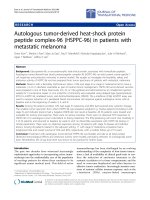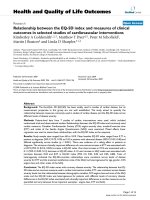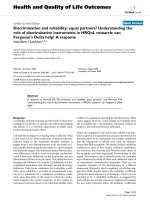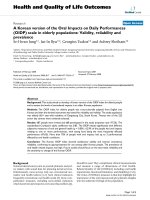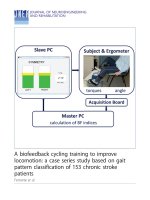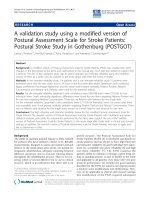báo cáo hóa học: " A case study on co-exposure to a mixture of organic solvents in a Tunisian adhesive-producing company" potx
Bạn đang xem bản rút gọn của tài liệu. Xem và tải ngay bản đầy đủ của tài liệu tại đây (400.96 KB, 8 trang )
RESEARCH Open Access
A case study on co-exposure to a mixture of
organic solvents in a Tunisian adhesive-producing
company
Imed Gargouri
1,2,3*
, Moncef Khadhraoui
1
, Catherine Nisse
2
, Ariane Leroyer
2
, Mohamed L Masmoudi
3
, Paul Frimat
2
,
Daniel Marzin
2
, Boubaker Elleuch
1
and Denis Zmirou-Navier
4,5,6
Abstract
Objectives: to assess environmental and biological monitoring of exposure to organic solvents in a glue-
manufacturing company in Sfax, Tunisia.
Methods: Exposure of volunteer workers, in the solvented glue-work-stations, in the control laboratory and in the
storage rooms of the finished products, was assessed through indoor-air and urine measurements. Informed
consent of the workers was obtained.
Results and discussion: The exposure indexes were found with high values in the solvented workshop as well as
in the control laboratory and were respectively, 8.40 and 3.12. These indexes were also correlated with hexane and
toluene indoor air concentrations. As to urine, the obtained results for the 2,5-hexandione and hippuric acid,
metabolites of hexane and toluene, respectively, were in accord with the indoor-air m easurements, with an
average of 0.46 mg/l and 1240 mg/g of creatinine.
Conclusion: This study assessed for the first time biological exposure to organic solvents used in Tunisian adhesive
industries. Although values are likely to underestimate true exposure levels, some figures exceed European and
American occupational exposure guidelines.
Keywords: Adhesive manufacturing, Organic solvents, Hexane, Bio-monitoring, Occupational exposure assessment
Introduction
Organic solvents are a group of mainly volatile com-
pounds widely used to dissolve other substances in
industrial processes among them adhesive manufacturing
ones. Through their handling, these solvents can be
released into the environment during production, sto-
rage, transportation and utilisation [1,2]. Being volatile,
they can quickly evaporate and thus might be found with
high concentrations in the air. They are consequently
commonly inhaled in their volatilized form and absorbed
via the respiratory tract [3-5]. They can also penetrate
deeply though the skin in case of a direct contact.
Among the chemical risks listed in the Tunisian adhe-
sive producing companies, organic solvents occupy by
far the first place [4,6]. However in spite of the large
quantity being used, there is little information on expo-
sure and on the adverse health effects solvents may
cause.
Sfax, the second largest town in Tunisia after the capi-
tal Tunis, is located further to the South. It is one of the
industrial and agricultural pillars of the Tunisian econ-
omy. Among its industries, adhesive manufacturing
companies are one of the main industrial bases in the
region. Generally speaking, their products are used in
variousfieldssuchasshoemaking,averyprosperous
activity in the area.
Prevention of occupational hazards, and more particu-
larly of chemical risks, is usually based on regulatory
procedures [2,7]. The Tunisian regulation on health in
the workplace however does not require employers to
carry out atmospheric exposure measurements nor to
assess biological exposure indexes (BEI) [8-10]. This
* Correspondence:
1
Water, Energy and Environment Laboratory, National school of Engineers,
Sfax University, Sfax - Tunisia
Full list of author information is available at the end of the article
Gargouri et al. Journal of Occupational Medicine and Toxicology 2011, 6:28
/>© 2011 Gargouri et al; licensee BioMed Central Ltd. This is an Open Access article distributed under the ter ms of the Cre ative
Commons Attribution License ( which permits unrestricted use, distribution, and
reproduction in any medium, provided the original work is properly cited.
investigation was therefore conducted as a set up of
occupational exposure study at an adhesive manufactur-
ing company where the mainly used solvents are a cet-
one, cyclohexane, n-hexane, methylethylketone, toluene
and trichloroethylene. The investigation aimed to assess
occupational exposure of the company volunteer’s work-
erstoamixtureofsolventsinordertoimprovethe
plant working conditions.
Material and methods
Presentation of the company
The adhesive company was created in the 1960’s. Cur-
rently, it consists of 5 work stations, 2 storage rooms for
the raw materials and finished products, a control
laboratory and an office. The total staffs are composed
of 45 employees: 7 administrators, 2 engineers, 5 techni-
cians, 29 workers and 2 drivers. The 5 production lines
correspond to the workshops of: dissolved, natural,
latex, powder and vinyl adhesives. The company is char-
acterized by th e stability of its staff and the absence of a
significant modification in the manufacturing p rocess
and therefore of occupational tasks since 2000. We
assume therefore that solvents exposure has been quite
steady for a long time. The work schedule is 8 hours/
day and 42 hours/week.
Regarding the company production area, it is made
of 5 workshops (Figure 1) according to the nature of
the raw material of adhesives. Each workshop has its
own characteristics; however in general, it is composed
of 2 principal sections. In the first one, adhesives of
different types are p roduced, with a maximum number
of 3 operators. Conditioning takes place in t he second
section where the number of permanent operators var-
ies from 2 to 7 according to the workshop and the
quantity of the produced adhesive. It is worth noting
that under some circumstances; in particular in case of
very important orders in one of the workshops, some
employees might move transitorily from one workshop
to another. In these workshops, various chemicals are
handled for adhesives manufacturing, among them
organic solvents whose daily and annual quantities are
listed in Table 1.
Study population
Twenty five employees who were working in the manu-
facturing and conditioning lines, in the control labora-
tory and in the storage halls of the finished products (10
men, 15 women, median age 44.8 years [min = 25, max
= 58] with an average seniority of 20.9 years in the com-
pany [min = 1, max = 40]) were suspected of exposure
to organic solvents. The work station of the dissolved
adhesive consisted of 9 employees (2 men and 7
women), with a 44.6 years median age [min = 25, max =
58] and an average seniority of 23.2 years [min = 6, max
= 35]. Ethical consideration was respected in every stage
and step of our investigation. The cooperation with this
company was within the fram e of a voluntary service on
solvents risk assessment via a written agreement with
the aim of improving conditions in the workshops of
the company. Also briefing and informatio n sessions on
all study aspects a nd goals w ere made in front of the
employees before the investigation kick-off. We assured
them that all results would be used anonymously with
their consent and only for scientific purposes.
Assessment of exposure to solvents
This study included several facets: (i) an observation of
the various work stations; (ii) an investigation with the
assistance of the management and the oldest employee
on the main modifications which had been taking place
overtime, both at the technical level (change of
machines, aspiration and ventilation of the buildings, )
and regarding the nature of solvents used; (iii) a retro-
spective assessment, with t he chemical engineer of the
company,oftheevolutionofthesolvents’ compositions
and quantities that are being used; (iv) and finally the
current study on personal exposure measurements and
bio-monitoring. The latter were carried out in May
2007. To do so, both personal and/or stationary sam-
plings were taken. The personal sampler holder was set
near the respirato ry person track whereas the stationary
sampler was fixe d on the earth and kept at the middle
height of an ordinary person. Sampling equipments con-
sist of a programmable low flow Pocket Pump (Pump
SKC
®
210-1002 TX) with a regular flow set to 100
(±5%) cm
3
/mn for 4 hours and an activated charcoal
tube 800 and 200 mg (Tube SKC
®
226-16) that traps
solvents present in the workplace air [11,12]. Once
sampled, the tubes were kept under 4°C and transported
to the laboratory for the measurement. After solvent
desorption in 5 ml of carbon bisulphide, the extract was
analyzed using gas chromatography (CPG) with and
external calibration mode. The column used is a semi-
capillary column HP-5MS (Length = 60 m, Diameter =
0,75 mm) and a flame ionization d etection mode (FID).
Temperature of the column was firstly set to 43°C to
rise till 180°C with a rate of 2°C/min.
Interpretation of the air concentration results was car-
ried out in reference to threshold limit values (TLV) for
solvents issued in 3 countries (USA, France and Ger-
many) on the basis of 8 working hours period/day and 39
hour s/week (Table 2) [3,13-18]. To account for the com-
bination of solvents we created a cumulative relative
index of personal exposure (I.exp) equal to: I.exp = C
1
/
TLV
1
+C
2
/TLV
2
+ + C
n
/TLV
n
Where C
n
and TLV
n
being respectively the measured concentration
and the corresponding limit value of a pollutant n. If I.
exp is higher than 1, exposure is regarded as excessive.
Gargouri et al. Journal of Occupational Medicine and Toxicology 2011, 6:28
/>Page 2 of 8
The corr esponding index based on stationary work place
measurements is called index of pollution (I.pol).
Regarding biological monitoring, 25 volunteering
workers participated via urine donations. Nearly 50 ml
was collected from each person in clean plastic tubes
and immediately kept in a cooling container of about 4°
C then transported to the laboratory and either directly
analysed or frozen to -20°C. Urine sampling was done
twice a week; at the end of the week and at the end o f
the work station (Thursday afternoon). Metabolite s of
the studied solvents were qua ntified using a high perfor-
mance liquid chromatogra phy (HPLC) [15,18,19].
Workshop of the
solvented Adhesive
Surface: 228.6 m
2
Number of workers: 11
Number of stations: 3
- Natural rubber Cutting
- Manufacture of the solvated adhesive
- Conditioning of the solvated adhesive
- Production line of additional product
Environment:
Wet
Ventilation:
Natural (door, window)
Extraction at the source
Solvents used: Organic
Workshop of
the Natural Adhesive
Surface: 129.37 m
2
Number of workers: 3
Number of stations: 2
- Manufacture of the Natural adhesive
- Conditioning of Natural adhesive
Environment:
Heat (boiler)
Ventilation:
Natural (door, window)
Solvent used: Water
Workshop of the
Latex Adhesive
Surface: 174 m
2
Number of workers: 3
Number of stations: 2
- Manufacture of the adhesive Latex
- Conditioning of the adhesive Latex
- Production line of calorex
Environment:
Heat (boiler)
Ventilation:
Natural (door, window)
Extraction at the source
Solvent used: Water
Workshop of the
Vinyl Adhesive
Surface: 113,75 m
2
Number of workers: 5
Number of stations: 3
- Primary Production of the vinyl adhesive
- Manufacture of the vinyl adhesive
- Conditioning of the vinyl adhesive
Environment:
Heat (boiler)
Ventilation:
Natural (door, window)
Extraction at the source
Solvent used: Water
Workshop of the
Powder Adhesive
Surface: 34 m
2
Number of workers: 2
Number of stations: 2
- Filling of the machine of
conditioning of the powder adhesive
- Conditioning of the powder adhesive
Environment:
Wet
Ventilation:
Natural (door, window)
Extraction at the source
Solvent used: nothing
Figure 1 Description of the various workshops. Workshop of the solv ented Adhesive: Rubber, Polychloroprene, Polyurethane and Produced
additional.
Gargouri et al. Journal of Occupational Medicine and Toxicology 2011, 6:28
/>Page 3 of 8
Separation column was Eurospher-100 C18 type with a
length of 250 mm and an internal diameter of 4.6 mm.
Themobilephasewasamixtureof900mlaceticacid
solution (2%) and 100 ml methanol. Mobile phase flow
rate was set to 1.5 ml under isocratic mode and a detec-
tion wave length of 250 nm. All urines samples were
firstly acidified with chlohidric acid to a pH around 1,
then centrifuged and finally filtered. Measurement wa s
conducted via the injection of an aliquot of 20 μlinto
the pre-calibrated high performance liquid chromato-
graphic apparatus. Results were compared to different
biological exposure limit values (BEI) drawn from the
literature (Table 3) [16,20]. Also, since non professional
exposure can have an influence both on the renal and
hepatic pathology and on the interpretation of the
results, an individual information chart was created for
each employee on which any other exposure different
from the professional one such as leisure activities,
smoking or any other aspects was specifed.
In the absence of Tunisian exposure limit values for
workplace air or biological monitoring [8-10] and as
mentioned above, we referred to t he French, American
and/or German values and adopted the most severe
among them (Table 2 and table 3) [3,12,13,21].
Results
In total, ten air samplings, five personal and five station-
ary as well as 25 urine samplings were carried out.
Table 4 summarizes the main results of the air measure-
ments (number of samples, average values and ranges).
It can be seen that air concentrations in the workshop
of the dissolved adhesive, in the control laboratory and
in the storage halls of the finished products were greater
than the TLVs (indexes are above 1; Table 4). Higher
concentrations of hexane were also found in the sol-
vented adhesive workshop (respective averages and
ranges, in the control laboratory and in the storage
rooms were 539.8 mg/m
3
[222.0-1415.0], 140.5 mg/m
3
[80.0-201.0] and 80.2 mg/m
3
). However, toluene concen-
trations did not exceed the limit value (respective
averages and ranges in the three above mentioned loca-
tions were 122.0 mg/m
3
[81.0-154.0], 56.0 mg/m
3
[51.0-
61.0] and 102.0 mg/m
3
). The other solvents, cyclohex-
ane, methylethylketone and trichloroethylene had lower
concentrations, in comparison with the TVS. As for
benzene it was undetectable.
Table 5 shows the results for the urine samples. They
revea led that concentrations of the 2,5-hexanedione and
hippuric acid, respectively biomarkers of hexane and
toluene, were high in the workshop of dissolved adhe-
sive. Also high concentration of the 2,5-hexanedione
was observed in certain employees’ urines working in
the vinyl adhesive workshop, in the latex adhesive
Table 1 Quantities of solvents used in the company and
chemical identification
Solvents Number Quantities (m
3
) during
CAS n° EINECS Year (%) Day of air
sampling
Acetone* 67-64-1 200-662-2 102.5
(17.5)
0.5
Butyl acetate 123-86-4 204-658-1 2.5 (0.4) -
Cyclohexane* 110-82-7 203-806-2 57.8 (9.9) 0.6
Ethyl acetate 141-78-6 205-500-4 33.5 (5.7) -
n-hexane* 110-54-3 203-777-6 120.0
(20.5)
2.0
Methylethylcetone* 78-93-3 201-159-0 150.0
(25.6)
1.7
Perchloroethylene 127-18-4 204-825-9 2.0 (0.3) -
Toluene* 108-88-3 203-625-9 116.0
(19.8)
1.5
Trichloroethylene 79-01-6 201-167-4 0.7 (0.1) -
*: solvents handled during the of air sampling period
Table 2 Workplace air concentrations limit values of studied solvents [1,3,8-10,20,21,23]
France
(EU
1
)
USA
(ACGIH
2
)
Germany
(MAK
3
)
Our Study
(Tunisia)
Solvent TLV
4
TLV-TWA
5
Adopted TLV
ppm
6
mg.m
-3
ppm mg.m
-3
ppm mg.m
-3
ppm mg.m
-3
Acetone 500 1210 500 - 500 1200 500 1200
Cyclohexane 200 700 300 - 200 700 200 700
n-hexane 20 72 50 - 50 180 20 72
Methylethylketone (MEK, 2-Methyl ethyl ketone) 200 600 200 - 200 600 200 600
Toluene 50 192 50 - 50 190 50 190
Trichloroethylene 75 405 50 - - - 50 -
(1) EU: European Union
(2) ACGIH: American Conference off Governmental Industrial Hygienists
(3) MAK: Maximum Arbeitsplatz-konzentration
(4) TLV: Threshold Limit Value to solvents calculated on the basis of 8 work hour period/day and 39 hours/week
(5) TLV-TWA: Time-Werghted Average (Median values balanced over 8 hours per days and 40 hours per weeks)
(6) ppm: shares per million and volume of air
Gargouri et al. Journal of Occupational Medicine and Toxicology 2011, 6:28
/>Page 4 of 8
workshop and in the storage rooms. Similarly, high
values of the 2,5-hexa nedione were recorded in the
urines of those working in the control laboratory with
an average of 1.14 mg/l). It is worth noting that in this
locati on, the 2 technicia ns were handling extremely lim-
ited quantities of adhesive samples, and collective and
individual protective equipments were available.
We noted that the workshop of the dissolved adhesive
consists of 2 communicating floors as shown in Table 6.
It has natural ventilation with 2 doors, 6 windows and
mechanical ventilation. In its 4 working stations (tur-
bines, manufacturing lines on the 1
st
floor and in the
three conditioning stations on the ground floor), the
levels of hexane surpassing both the air and biological
limit values were noted, mainly at the station of the
turbines. In these locations also, we noticed that in spite
of the presence of general and individual protective
equipments available for all the employees (specific
masks and gloves), only 10% were using them.
Discussion
This study reports that workplace air and personal
exposure concentrations of several VOCs are exceeding
threshold limit values set at developed industrialized
countries. The solvented adhesive workshop was where
exposures were the greatest, namely for hexane and its
biomarker the 2,5-hexandione.
Several studies have discussed how utilisation of sol-
vents has gone through a significant great evolution as
well as prevention measures and regulations in
Table 3 Biological exposure limit values of studied solvents [8-10,19,20,22-24]
France
(EU)
USA
(ACGIH)
Germany
(DFG
1
)
Our Study
(Tunisia)
Biological Exposure index
(BEI) in Urine
FGV
2
(1997)
BEI
3
BAT
4
Adopted
BEI
Acetone 100 mg/l 50 mg/l 80 mg/l 50 mg/l
1,2-cyclohexanediol - - 170 mg/g creat 170 mg/g creat
2,5 hexanedione - 0.4 mg/l - 0.4 mg/l
Methylethylketone - 2 mg/l 5 mg/l 2 mg/l
Hippuric acid 2500 mg/g creat 1600 mg/g creat - 1600 mg/g creat
Trichloroacetic acid 100 mg/g creat 80 mg/l
[15 mg/l
(Proposal 2007)]
A 15 mg/l
(1) DFG: Deutsche Forchungs-Gemeinschaft
(2) FGV: French Guide Value
(3) BEI: Biological Exposure Indices
(4) BEATS: Bioloischer Arbeitsstoff-Toleranz-Wert (biological values tolerated
in professional environment)
(A)
Concentration of Trichloroethylene
in the air (ml/m
3
)
Acid trichloroacetic
in the urine (mg/l)
10 20
20 40
30 60
50 100
Table 4 Exposure indices according to the workshop
Type of workshop Personal exposures Environmental samplings
Index of exposure Index of pollution
N range average N average
Solvented adhesive workshop 4 4.09 - 20.1 3 8.40 - -
Non-solvented workshops (natural adhesive, vinyl adhesive, latex adhesive) - - - 3 0.01
£
Analysis laboratory 1 - 3.12 1 1.49
Finished products store - - - 1 1.70
Total = 5 Total = 5
Personal exposure: Index of exposure (I.exp)/Environmental sampling: Index of pollution (I.pol)
I.exp = C
1
/TLV
1
+C
2
/TLV
2
+ + C
n
/TLV
n
C
n
and TLV
n
being respectively the measured concentration and the limit value of pollutant n.
£
all three index values were 0.01.
Gargouri et al. Journal of Occupational Medicine and Toxicology 2011, 6:28
/>Page 5 of 8
solvented workplaces. This evolution has also touched
the modifications of solvents nature and the way they
are handled [3,11]. However, it was reported that the
number of workers exposed to solvents has been
increased. For instance in France, the SUMER 2003
study shows that between 1994 and 2003, the propor-
tion of exposed workers passed from 12.2% to 14.7%,
especially in the chemical industry [1].
In addition, risk a ssessment studies have been con-
ducted in various industrial sectors. However, the adhe-
sive manufacturing area has been somehow neglected
[3]. To the best of our knowledge, this is the first expo-
sure study ever conducted in the adhesive manufactur-
ing sector in Tunisia. This work also included a
qualitative appreciation of the risk by a careful investiga-
tion of the working stations and an inventory of the
products that were handled. Environmental and biologi-
cal measurements were performed in our study in the
framework of an effort to assess their impact on humans
[22,23].
As was mentioned above, fa ced with the absence of
data in the literature dealing with devel oping countries
comparable to Tunisia, we referred to data used in the
more developed world. Found results revealed that the
cumulative indexes of exposure were much higher than
1 in particular in the three studied locations, with great-
est values in the solvented adhesive workshop. Indeed
an average of 8.40 was noted in this location; meanwhile
the lowest value (4.09) was recorded in one of the con-
ditioning stations and the maximum value of 20.13 at
the turbines stations. In Washington DC (USA), in an
aerospace manufacturing company the average (range of
observed values) cumulative exposure index for VOCs
among painters was 3.77 (0.20-10.6) [20]. In Japan, dur-
ing the summer season of 1999, the ave rage of solvent
exposure index in furniture factories was 0.35 (maxi-
mum = 5.35); distinctively for hexane. Also, the mean
concentration was 1.0 mg/m
3
with a maximum of 45.5
mg/m
3
for the same solvent [21].
Whereas in Spa in, according to Cardona [24,25], the
average values of hexane and toluene a mong shoe fac-
tory workers (individual exposure), were respectively 47
mg/m
3
and 86 mg/m
3
, and ranging respectively between
4 to 652 mg/m
3
and 2 to 1143 mg/m
3
.InItaly,under
almost the same working environment conditions, Bal-
dasseroni [26] found an average individual value of 0.86
mg/l for the 2.5-hexandione, close to what we found in
the solvented adhesive workshop and which was equal
to 0.46 mg/l. In California, Wilson MP et al. [27] con-
ducted a study on vehicle repair industry where aerosol
products containing hexane, toluene, acetone and
methyl ethyl ket one were used e xtensively. They
reported an average (range) of hexane and toluene air-
concentra tions in vehicle repair shops of 28 mg/m
3
(2
Table 5 Urine concentrations of solvents metabolites according to the activity of the workshop
Type of workshop Acetone
(mg/l)
2,5 hexandione
(mg/l)
Hippuric acid
(mg/g créat)
Metylethylketone
(mg/l)
Trichloracetic acid
(mg/l)
N range average range average range average range average range average
Solvented adhesive
workshop
9 2.30 - 20.40 6.87 0.12 - 0.98 0.46 92 - 1850 1248 0.20 - 3.80 1.22 4.00 - 21.00 7.67
vinyl adhesive workshop 5 3.30 - 5.20 3.80 0.25 - 1.56 0.99 111 - 742 383 - < 0.2 0.01 - 0.04 0.02
Natural adhesive workshop 3 2.00 - 6.70 4.23 0.10 - 0.52 0.26 85 - 860 350 - < 0.2 0.01 - 0.20 0.08
latex adhesive latex
workshop
4 4.10 - 5.20 4.58 0.10 - 0.89 0.50 128 - 467 299 - < 0.2 0.01 - 0.05 0.03
Quality control laboratory 2 6.20 - 7.90 7.05 0.64 - 1.64 1.14 186 - 360 273 - < 0.2 0.01 - 1.04 0.53
storage of the finished
products
2 3.70 - 5.00 4.35 0.24 - 1.14 0.69 45 - 513 279 - < 0.2 - 0.04
Total = 25
N: number of employees -: not manipluled in the workshop
Table 6 Concentrations of hexane and its biological indicator in the workshop of the solvented adhesive
Hexane concentration 2,5 hexandione Concentration (mg/l)
Location Stations Operators mg/m
3
ppm range average
1st floor Turbines 2 men 1415.0 418.2 0.60 - 0,98 0.79
Ground floor Conditioning 1 3 women 233.0 68.9 0.17 - 0,80 0.38
Conditioning 2 2 women 222.0 65.6 0.12 - 0,40 0.26
Conditioning 3 2 women 289.0 85.4 0.38 - 0,51 0.45
Average in the workshop 539.8 159.5 0.12 - 0.98 0.46
C
i
: Conditioning ●: permanent agent: : reinforcement agent
Gargouri et al. Journal of Occupational Medicine and Toxicology 2011, 6:28
/>Page 6 of 8
to 100) and 11.2 mg/m
3
(2 to 21), respectively. Another
study showed that in 2004 [28], in a French serigraphy
company, the median atmos pheric concentration of sol-
vents was 80.1 mg/m
3
for benzoic hydr ocarbons. In the
Netherlands, Hertsenberg et al [29] found average hex-
ane and toluene concentrations r espectively of 25.7 and
26.0 mg/m
3
in shoe repair shops during 2005. Average
urinary concentration of 2,5-hexandione was 3.2 ± 2.9
mg/l among shoe makers in Turkey in 1997 [30], and
the mean of hexane was 411.6 mg/m
3
.
In the current study, high values of 2,5-hexanedione
(metabolite of hexane) were observed in the urines of the
employees working in the vinyl adhesive workshop.
Recently, air concen trations have been lower than the
TLVs in this workshop. This can be explained by the fact
that these workers are sometimes called to help their col-
leagues in the solvente d adhesive workshop at the condi-
tioning stations in case of important orders. Hexane
level s were higher than the reference values in the urines
of the 2 technicians. This was a surprising finding since
one of the technicians had been working there just for 15
days. Indeed, despite a freque nt handling of solvented
adhesive for quality control, hexane and other solvents
were in tiny quantities in this place. A n ew visit to the
labora tory revealed that cleaning of the laboratory equip-
ments at the end of the station was done with hexane in
spite of the rules prohibiting such usage.
As this was the first assessment of exposure to organic
solvents, one limitation of this investigation was that it
involved only one company but which is considered as
having an advanced policy towards work condition
improvement and where workers were participating
voluntarily. Moreover, although the number of the
exposed persons might be small, we believe that this
does not affect the authenticity and the findings of the
investigation. Indeed, the sampling methodology was
conducted to mainly identify where employees are sup-
posed to be exposed to the highest values of organic sol-
vents and not according to the size of the company
manpower in concordance with what is reported else-
where [4,11,12].
Probably, another weakness of th is study is that i t was
conducted during a relatively narrow time period. In
fact, the production activity varies throughout the year
according to orders and this may affect the working
atmosphere quality. Also the natural ventilation of the
different workshops is influenced by seasons. For
instance, doors or windows are open during the hot per-
iod and also at the time of the current investigation.
Interestingly, the types of solvents, and the propor-
tions reported in Table 1 were comparable with those
described by Samato et al. in K yoto, Japan (April 2004
to March 2005) [31] where the solvents used in an
adhesive industry were toluene (47%), ethyl acetate
(42,5%), MEK (33%), acetone (27%) with lower usage of
trichloroethylene.
Finally we note that neuropsychiatry symptoms asso-
ciated with chronic exposure to organic solvents have
been described for a long time. The effects of chronic
and sub-chronic exposure to these studied organic sol-
vents on balance control of our volunteer workers have
been published in a previous paper [32].
Conclusion
Although regulations exist, pollution biomonitoring is
not yet compulsory eit her in Tunisia or other countries
alike. We recall that we conducted a regional survey and
had spent almost 10 months gathering information on
all adhesive manufacturers and users in this region to
finally carry o ut this study with this cooperating com-
pany. Therefore, it can be concluded that this study
establishes the first report on the profile of occupational
exposure to organic solvents used in the Tunisian adhe-
sives producing industries. High exposure levels were
recorded in the studied company which is likely to offer
better work conditions compa red to the many others of
the country. Nonetheless, it is worthwhile to replicate
the current investigation in other parts of the country
and set a preliminary data base for the Tunisian Work
Health Association.
Acknowledgements
This investigation was partly financially supported by Sfax University. The
authors wish to thank the owner and all responsible persons of SIFCOL
adhesive company as well as all the workers who voluntarily took part in
the study.
Author details
1
Water, Energy and Environment Laboratory, National school of Engineers,
Sfax University, Sfax - Tunisia.
2
University laboratory of Occupational
Medicine and Occupational Hazards, EA 2690 Poisons and occupational
carcinogens and the environment. Medical School, Lille 2 University, Lille -
France.
3
Department of Occupational Medicine and Professional Pathology,
University Hospital/Medical School, Sfax University, Sfax - Tunisia.
4
Inserm
U954 (National Institute for Health and Medical Research), Nancy - France.
5
School of Medicine, Nancy University, Vandoeuvre-lès-Nancy - France.
6
EHESP School of Public Health, Rennes - France.
Authors’ contributions
IG was involved in the conception and design of the project, data
collection, data analysis, data interpretation, manuscript writing, and final
approval of manuscript. MK was involved in the conception and design of
the project, data collection, data analysis, data interpretation, manuscript
writing, and final approval of manuscript. CN was involved in the
conception and design of the study and data interpretation. AL participated
in the design of the study and performed the statistical analysis. MLM
contributed to the data interpretation. PF was involved in the data
interpretation. DM contributed in the data interpretation. BE contributed to
the conception and design of the project, data collection, data
interpretation, manuscript writing, and final approval of manuscript. DZN
was involved in the conception and design of the project, data
interpretation, manuscript writing, and final approval of manuscript. All
authors read and approved the final manuscript.
Competing interests
The authors declare that they have no competing interests.
Gargouri et al. Journal of Occupational Medicine and Toxicology 2011, 6:28
/>Page 7 of 8
Received: 20 September 2010 Accepted: 14 November 2011
Published: 14 November 2011
References
1. Triolet J: Panorama de l’utilisation des solvants en France fin 2004. Cahier
Notes Doc 2005, 199:65-97.
2. Logman JFS, De Vries LE, Hemels MEH, Khattak S, Einarson TR: Paternal
organic solvent exposure and adverse pregnancy outcomes: A meta-
analysis. Am J Ind Med 2005, 47:37-44.
3. Poirot P, Hubert-Pelle G: Profils d’exposition aux solvants et comparaison
aux valeurs limites de courte durée. Cahier Notes Doc 2005, 200:83-93.
4. Poirot P, Subra I, Baudin V, Héry M, Chouanière D, Vincent R: Détermination
du profil d’exposition à moyen terme de peintres en bâtiment. Cahier
Notes Doc 2000, 179:5-13.
5. Tkaukiainen A, Vehmas T, Rantata K, Numinen M, Martikainen R, Taskinen H:
Results of common laboratory tests in solvent-exposed workers. Int Arch
Occup Environ Health 2004, 77:39-46.
6. Preller L, Burstyn I, De Pater N, Kromhout H: Characteristics of peaks in
inhalation exposure to organic solvents. Ann occup Hyg 2004, 48 :643-252.
7. Dor F, Bonvallot N: Identification des dangers : une étape de l’évaluation
des risques sanitaires à approfondir. Environnement, Risque et Santé 2005,
6:279-287.
8. Journal Officiel de la République Tunisienne (JORT): Décret n° 2000-1985
du 12 septembre 2000, portant organisation et fonctionnement des
services de médecine du travail. JORT 2000, 76:2250-2253.
9. JORT: Loi n° 94-28 du 21 févier 1994, portant régime de réparation des
préjudices des accidents du travail et des maladies professionnelles.
JORT 1994, 15:308-318.
10. JORT: Loi n° 95-56 du 28 juin 1995, portant régime de réparation des
préjudices des accidents du travail et des maladies professionnelles
dans le secteur public. JORT 1995, 53:1419-1424.
11. Hervé-Bazin B: Guide d’évaluation de l’exposition au risque toxique sur
les lieux de travail par échantillonnage de l’atmosphère. Cahier Notes Doc
1989, 135:265-288.
12. Institut de Recherche en Santé et en sécurité au Travail (IRSST) - Direction
des opérations: Guide d’échantillonnage des contaminants de l’air en
milieu du travail.
IRSST, Canada (8ème édition) 2005 [],
T-06:191 pages.
13. Courtois B: Valeurs limites d’exposition professionnelle aux agents
chimiques en France. Institut National de Recherche et de Sécurité [INRS]
(France) 2007, ED 984:19 pages.
14. Journal Officiel de l’Union Européenne (JOUE): Directive 2006/15/CE du 7
février 2006 établissant une deuxième liste de valeurs listes indicatives
d’exposition professionnelle en application de la directive 98/24/CE du
conseil et portant modification des directives 91/322/CE et 2000/39/CE.
JOUE 2006, L36-L39 (FR).
15. Pillière F, Conso F: Biotox: Guide biotoxicologique pour les médecins du
travail. INRS (France) 2007 [], ED 791:252 pages.
16. Schneider O, Brondeau M-T: Indices Biologiques d’Exposition. Cahier Notes
Doc 2006, 202:49-65.
17. Triolet J: Valeurs limites d’exposition professionnelle aux substances
dangereuses. Valeurs de l’ACGIH (Etats-Unis) et de la Commission MAK
(Allemagne). Cahier Notes Doc 1999, 176:59-90.
18. Truchon G: Guide de surveillance biologique: Prélèvement et
interprétation des résultats. IRSST, Canada (6ème édition) 2004 [http://
www.irsst.qc.ca], T-03:92.
19. Pergiago JF, Cardona A, Marhuenda D, Roel J, Villanueva M, Marti J, Luna A:
Biological monitoring of occupational exposure to n-hexane by exhaled
air analysis and urinalysis. Int Arch Occup Environ Health 1993, 65:275-278.
20. Daniell WE, Claypoole KH, Checkoway H, Smith-Weller T, Dager SR,
Townes BD, et al: Neuropsychological function in retired workers with
previous long term occupational exposure to solvents. Occup Environ
Med 1999, 56:93-105.
21. Gong Y, Kishi R, Kasai S, Katakura Y, Fujiwara K, Umermura T, et al: Visual
dysfunction in workers exposed to a mixture of organic solvents.
Neurotoxicology 2003, 24:703-710.
22. Grandjean P, Budtz-Jørgensen E: Total imprecision of exposure
biomarkers: Implication for calculating exposure limites. Am J Ind Med
2007, 50:712-719.
23. Lin YS, Kupper LL, Rappaport SM: Air samples versus biomarkers for
epidemiology. Occup Environ Med 2005, 62:750-760.
24. Cardona A, Marhuenda D, Marti J, Brugnone F, Roel J, Perbellini L:
Biological monitoring of occupational exposure to n-hexane by
measurements of urinary 2,5-hexadione. Int Arch Occup Environ Health
1993, 65:71-74.
25. Cardona A, Marhuenda D, Prieto MJ, Marti J, Periago J-F, Sanchez J-M:
Behaviour of urinary 2,5-hexanedione in occupational co-exposure to n-
hexane and acetone.
Int Arch Occup Environ Health 1996, 68:88-93.
26. Baldasseroni A, Bavazzano P, Buiatti E, Lanciotti E, Lorini C, Biggeri A:
Occupational exposure to n-hexane in Italy, analysis of a registry of
biological monitoring. Int Arch Occup Environ Health 2003, 76:260-266.
27. Wilson MP, Katharine Hammond S, Nicas M, Hubbard AE: Worker exposure
to volatile organic compounds in the vehicle repair industry. J Occup
Environ Hyg 2007, 4:301-310.
28. Vouriot A, Hannhart B, Gauchard GC, Barot A, Ledin T, Mur JM, Perrin PhP:
Long-term exposure to solvents impairs vigiliance and postural control
in serigraphy workers. Int. Arch Occup Environ Health 2005, 78:510-515.
29. Hertsenberg S, Brouwer D, Lurvink M, Rubingh C, Rijnders E, Tielemans E:
Quantitative self-assessment of exposure to solvents among shoe repair
men. Ann Occup Hyg 2007, 51:45-51.
30. Elci OC, Yener G, Ucku R: Working conditions and related
neuropsychiatric problems among shoe makers in Turkey: Do child
workers differ from others? Indian J Occup Environ Med 2007, 11 :9-14.
31. Samoto H, Fulkui Y, Ukai H, Satoru O, Takada S, Ohashi F, et al: Field survey
on types of organic solvents used in enterprises of various sizes. Int Arch
occup Environ Health 2006, 79:558-567.
32. Herpin G, Gargouri I, Gauchard G, Nisse C, Khadhraoui M, Elleuch B, Zmirou-
Navier D, Perrin P: Effect of chronic and subchronic organic solvents
exposure on balance control of workers in plant manufacturing
adhesive materials. Neurotox Res 2009, 15:179-186.
doi:10.1186/1745-6673-6-28
Cite this article as: Gargouri et al.: A case study on co-exposure to a
mixture of organic solvents in a Tunisian adhesive-producing company.
Journal of Occupational Medicine and Toxicology 2011 6:28.
Submit your next manuscript to BioMed Central
and take full advantage of:
• Convenient online submission
• Thorough peer review
• No space constraints or color figure charges
• Immediate publication on acceptance
• Inclusion in PubMed, CAS, Scopus and Google Scholar
• Research which is freely available for redistribution
Submit your manuscript at
www.biomedcentral.com/submit
Gargouri et al. Journal of Occupational Medicine and Toxicology 2011, 6:28
/>Page 8 of 8



